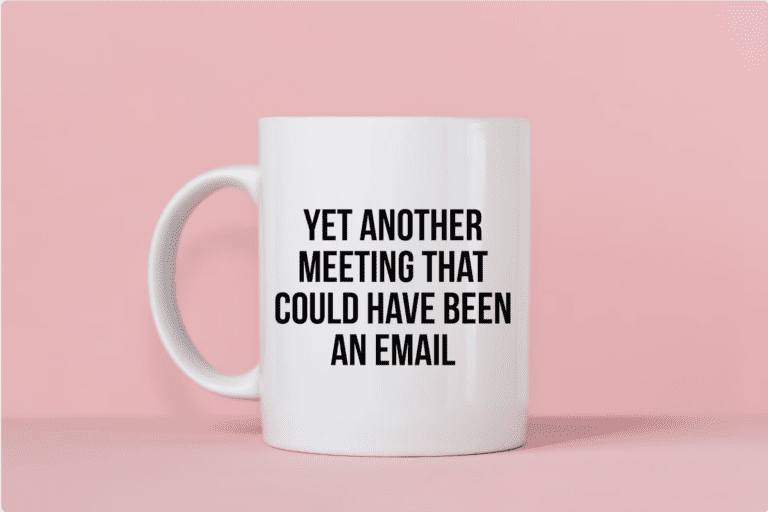7 Signs This Meeting Could Have Been an Email

While meetings (in-person or virtual) can be great for getting projects done and team camaraderie, they also can be a massive time-suck.
I don’t know about you, but too many meetings lead to Zoom fatigue for me. Plus there were many times I personally thought a particular meeting could have been an email.

Yup, this mug is a popular seller on Etsy. There are plenty of memes and other novelty items around this very topic too.
But I’m also guilty of scheduling meetings that I probably didn’t need to either. Leaving my team feeling burnt out just like I have in the past. Oops!
Below, I’ll share some signs that your meeting should be an email instead and how to approach your team about unproductive meetings.
7 Signs Your Meeting Could Have Been An Email
Before you schedule a meeting, think about the impact on your work, the team, and the company. Often, meetings will do more damage to productivity than you initially realize.
And teammates are probably thinking about the waste of time meetings can be too.
For example, a SurveyMonkey study on virtual meetings found 32% of people find themselves thinking, “this meeting could have been an email” all or most of the time.
So below are some common signs you’re better off sending an email to the appropriate people instead of hosting a meeting.
1. You just need to ask a simple question
If you have a particular question, usually this can simply be an email or instant message to the colleague instead of a meeting.
Otherwise, you could be interrupting their workflow on something non-urgent that would take a quick reply back.
2. You have a general announcement
Most general announcements don’t require to be said in a meeting, especially if it’s off topic from what the agenda is about.
There will be times when an announcement is very important. At that stage a meeting might be warranted, but that’s what the focus should be on in that meeting. These meetings should allow for discussion, questions, or concerns to be shared among the group.
General rule: Quick announcements should be email. For major updates, then opt for the meeting.
3. You want feedback or updates on something
Sometimes in a meeting, you may bring up the need for feedback on something you are working on. Or maybe you wanted to get an update from a co-worker on a specific task or project.
This puts people on the spot and risks not getting the quality feedback or update you need. Instead, ask or share in an email with the requested info or feedback on the project you need.
This gives everyone more time to get to it on their time and reduces groupthink.
4. You already had a meeting on the topic
If you are having meetings covering the same things all the time, you’ll lose interest and everyone else's attention will be lost. And it typically means the meeting isn't productive or managed as it should to be valuable to all involved.
What’s worse than a meeting that could have been an email? Recurring meetings that also could be updated in an email or in a shared and accessible document instead!
5. You don’t have a clear agenda for the meeting
If you don’t have time to prepare or can clearly communicate the importance of the meeting, then skip it and go to email.
When there is no clear plan or objective to the meeting, it quickly becomes time wasted and annoying to everyone involved.
If it’s necessary to have a meeting, take some time to better plan it out before inviting colleagues. And if you realize it’s not critical to talk face-to-face or virtual, send out the details in email to those that need to be involved.
6. Those involved have back-to-back meetings
Depending on your co-workers or managers' role, they might be in back-to-back meetings throughout specific days. And those already can be exhausting to them.
So, do you really NEED to add another on their calendar?
Of course if it is urgent or extremely important to the business, then it’s understandable to schedule a meeting.
But if it can be avoided, stick to an email with the appropriate people added. You’ll provide them all some relief in their work day from having to hop in yet another meeting.
7. You're unsure who is relevant to the meeting
If you aren't sure of the roles colleagues play, trying to guess and invite a bunch to a meeting is not a good policy.
This can increase the chance of inviting those who are not relevant to the discussion and really don't need to be there. Plus, you'll look disorganized and cause time to be wasted by pulling people from their work.
Before booking anyone's calendar, think about "who" and "why" someone needs to be involved. And if you aren't sure, email everyone who you think should in the meeting first or connect with your manager to figure out who is relevant.
How to Act When The Meeting Could Have Been an Email
If you are on the receiving end of meetings that clearly don’t need to exist, it can start to be irritating to you as well. And it can impact your mood where you start hating work.
But you have a few options to address it as well as make them more productive.
Block off calendar for deep work
On your calendar, create some blocks of time where you don’t want meetings booked. This can be deep work sessions or simply a “No Meetings Please” block.
Not every co-worker will respect that block, but add them in anyway. You can always auto-deny the invites during these times. This helps you create boundaries with everyone and can help eliminate wasteful meetings from your work day.
Also, do not abuse these calendar blocks either. Like putting 5-8 hour blocks, you may get some suspicious feeling from colleagues or inquiries from your boss.
Turn the meeting into a creative session
If you end up stuck in a meeting that could have been an email, it probably means it’s not very productive.
However, you can flip direction by suggesting ideas, improvements, or guiding into a creative session with everyone involved.
It might feel a little awkward at first, but taking the initiative could steer the meeting into something even more useful.
And you can also discuss how to make meetings stronger, less frequent, and take everyone's ideas into consideration to make time more productive.
Have a conversation
If the meeting frequency is getting out of control and none of the previous tips have helped, then it’s time to have a more serious chat. Involve the team and manager(s) as needed.
It’s might be tough to chat about and approach the subject as you don’t want to be overly confrontational yet still remain firm in your views. Here’s some tips to keep in mind:
- Don’t blame anyone, even if there is a clear culprit. Share what you’ve noticed and the issues you have been feeling lately.
- Propose some solutions when it comes to meetings and how to best communicate as a team. Just complaining can sometimes be a bad look, so take initiative in how you think things can be improved.
- Ask how others are feeling about what you shared, if they have ideas, and what they think about the current meetings and frequency.
Other ways to Communicate Besides a Meeting or Email
Lastly, technology has improved the way we communicate with each other at work.
Whether you work in-person, hybrid, or remotely – there are various ways to share information without a meeting or email.
Other options:
- Instant or scheduled messaging (Slack, Microsoft Teams, etc.)
- Video messaging (Loom, Slack Huddles, Zoom, etc.)
- Project management tools (Asana, Trello, Basecamp, etc.)
Of course, check in with your manager, team, and employee handbook on the tools accessible and how to best communicate. A good company will ensure these are addressed so you aren’t left in the dark about various processes.
It’s best to think of it this way:
- Action items and sensitive information are best for meetings.
- General information or questions can be handled via email.
- Quick questions or discussion items are best via instant messaging.
You’ll notice some overlap in using email and instant messaging, but just use your best judgment. Plus, it’s easier to catch on to where colleagues communicate the most, so you can choose that particular channel then.
And a reminder, be a good co-worker when communicating no matter which form it is. You don’t want to be the annoying one constantly messaging people or scheduling meetings either.












